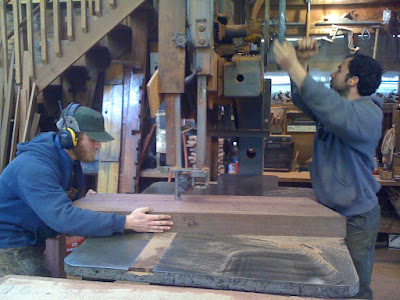I am a lover of tools, and the shipwrights of Haven Boatworks have many. They use traditional tools and have tricks of the trade gleaned from the vast history of boatbuilding, but they also use power tools to expedite the overall restoration. The results are beautiful and efficient.
 One of my favorite traditional tools the shipwrights carry is the bevel gauge. The picture to the left is a spread of shipwright Leland's tools. You can see three bevel gauges: two small brass ones in the bottom-middle of the picture, and a larger sliding bevel-gauge in the top middle. The metal ruler is Leland's bevel board; on the back it has specifically angled lines etched in so you can compare the bevel gauge to the bevel board to find your angle.
One of my favorite traditional tools the shipwrights carry is the bevel gauge. The picture to the left is a spread of shipwright Leland's tools. You can see three bevel gauges: two small brass ones in the bottom-middle of the picture, and a larger sliding bevel-gauge in the top middle. The metal ruler is Leland's bevel board; on the back it has specifically angled lines etched in so you can compare the bevel gauge to the bevel board to find your angle.From top to bottom, the tools are as follows: (row 1) a combination square, a sliding bevel gauge, a hand planer; (row 2) a bevel board, a folding knife, a spiling block, a folding ruler, an awl; (row 3) two sizes of bevel gauges. The square is for measuring and being sure things are "square," i.e. at 90 degree angles. The awl is good for a lot of things, like making marks on wood or probing for rot. It is the spiling blocks, however, are curious and genius tools.
 My own description of spiling would be a little rough, so here's a link that explains it better: Spiling. Spiling is the process of making a pattern of an existing futtock so you can make a new, sister futtock. Through this process, our frames are being reconstructed. You can see Brad at right using spiling blocks to make a pattern on the spiling batten.
My own description of spiling would be a little rough, so here's a link that explains it better: Spiling. Spiling is the process of making a pattern of an existing futtock so you can make a new, sister futtock. Through this process, our frames are being reconstructed. You can see Brad at right using spiling blocks to make a pattern on the spiling batten.There are many other tools the shipwrights harness: pry bars, hammers, mallets, drills, sawzalls, bandsaws, table saws, chisels, slide hammers, braces, pencil sharpeners, and so on. I am continually being impressed by their talents and knowledge, and I am proud to be working alongside them during this restoration project.
The picture above is of Brad and Leland using the ship's saw to cut a futtock. Brad is careful to keep the saw abreast of his markings while Leland is changing the angle of the saw. 5 degrees, 6 degrees, 7 degrees...
Project Update
The rest of the preservation and maintenance is going well. Here is an list of some things we've done.
Project Update
The rest of the preservation and maintenance is going well. Here is an list of some things we've done.
- Continually replacing futtocks
- Removed mast wedges to check masts
- Painted anchor chain
- Completely disassembled, cleaned, and painted the Edson Patent Gyber
- Removed & replaced deck bungs
- Overhauled main-cabin stove, Lucy
- Put Dutchmen in the deck (carved out rot and put in new wood)
- Checked shaft alignment
- Overhauled bilge alarms
Pictures (top to bottom): New frames next to the old! Amazing that these futtocks have survived; Nora working under the engine; Lara clearing rot for the Dutchman; A mast wedge removed; Adam proud of his sanding on the main-cabin hatch; A pretty picture of our new futtocks against the hull








WOW! I stopped by for a bit this weekend, and had the opportunity to connect with the wonderful crew and volunteers. Kudos to the sense of community and joy that the Adventurous brings to the community of Port Townsend and the greater Puget Sound. It made me happy to witness such an eclectic group of young and adults selflessly focused on a meaningful project. And, the vegetarian meals were like icing on the cake!
ReplyDelete